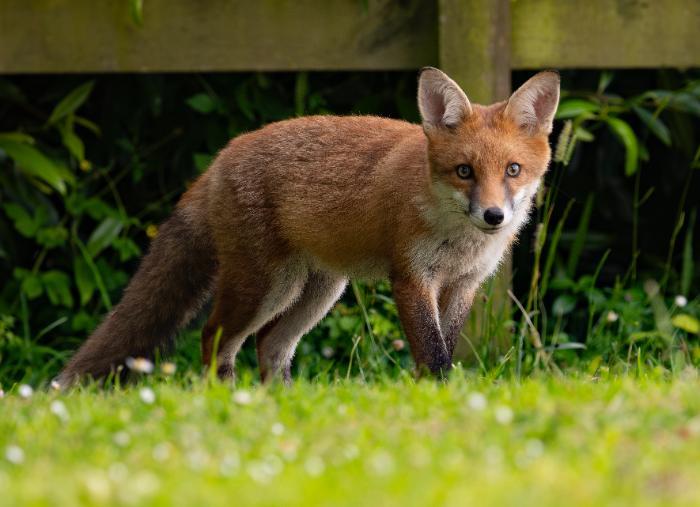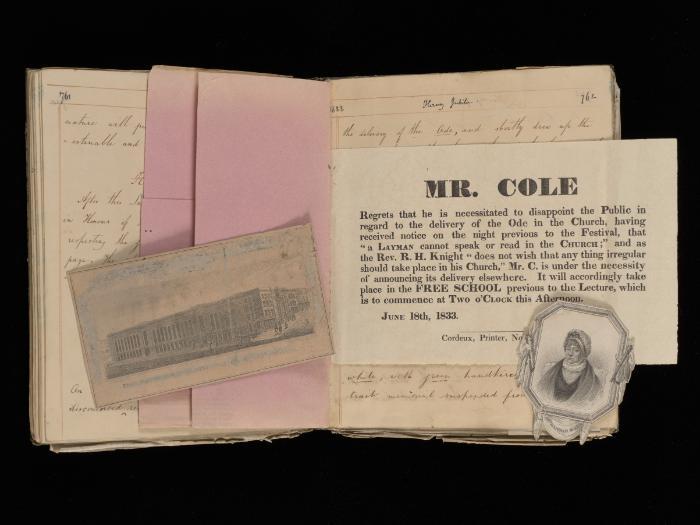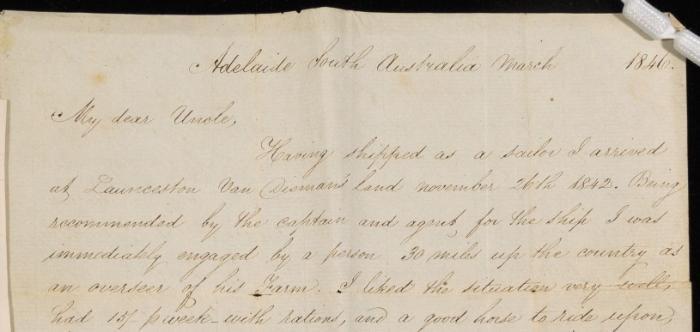Borthwick Newsletter - July 2024
Posted on 28 June 2024
July in the Archives - delve into our catalogues with this month’s featured description
Sir Charles Wood, 1st Viscount Halifax: Halifax Election, 7 July 1852. Includes reports in the Halifax Courier; election addresses printed and speeches printed; disputes after the election with H. Edwards and E. Jones, with printed addresses, etc; poll book printed; and re-election of 1st Viscount on his elevation to Presidency of Board of Control, Jan 1853. [Halifax Family and Estate Archive, HALIFAX/A4/24]
What’s New?
It seems the summer has finally arrived with some baking hot temperatures on campus - the resident Borthwick foxes have even been spotted doing some sunbathing. Most of the students have now left for the holidays but work continues as normal in the archives with our usual round of onsite researchers and offsite enquiries, visits, exhibition planning, accessioning, and cataloguing.

Among our many summer projects will be the continuing work on the new Discover York Digital Library, which is already home to a selection of our digitised records and will, we hope, become the home of many more. Currently you can see the records of the Diocesan church courts, the Archbishops Registers, the wartime diaries of Lord Halifax, photographs from the university and Vickers Instruments archives, and the famous portraits of the Rowntree ‘Aero Girls’. When using the site you might notice that it’s described as being in ‘beta mode’, meaning it’s still in the testing phase before being officially released. This phase allows our IT colleagues, together with Borthwick and library staff, to see how the website works, to fix any bugs and, crucially, to gather user feedback on it. To that end, if you do use the site we would love to know what you think. You can click the ‘Feedback’ button on the top right of any page to fill in the short form, and your feedback will help us to make the service better before its official launch.
New Accessions
We received two additions to existing archives in June. As well as an addition to the University of York Student Life Collection, which includes records of the university’s Archaeology and Labour Students societies, leaflets and student newspapers all dated between 1981 and 1992, we also accepted an addition to our Cooke, Troughton and Sims archive. The latter were a York based manufacturer of scientific instruments and the new addition comprises three volumes of information on their microscopes. We frequently receive enquiries from researchers who own a Cooke, Troughton and Sims microscope and want to know more about it, so we anticipate these volumes will get plenty of use.
We also took in three brand new archives. The earliest is the archive of John Cole (1792-1848), a Yorkshire bookseller, writer, publisher and antiquarian. We were able to purchase this archive thanks to a grant from the Friends of the National Libraries and it is a valuable addition to our collections, complementing the diaries of John Cole in York Minster Archives. After serving an apprenticeship as a bookseller and bookbinder in Northampton, Cole went on to set up his own business in Yorkshire, first at Hull and then at Scarborough. Cole was always interested in the areas in which he lived, publishing works of local history that are all the more rare for having been printed in batches of only 50-100 copies. The archive includes several manuscript volumes of Cole’s unpublished memoirs, providing us with a unique insight into the early 19th century book trade, as well as art work, news clippings and proof copies of books.

Another 19th century addition is the archive of York Racecourse which dates from the 1830s to the present day. York Racecourse was founded in 1731, although the first detailed records of a race meeting in the city date from 1709 on Clifton Ings. As the Ings were prone to flooding another site was needed and work soon began to level the ground at the Knavesmire outside of the city walls. The first race was held in 1731 and the first grandstand was erected in 1756, designed by York architect John Carr. Since then the York Races have become a highlight of the city’s social calendar. The archive includes the records of York Race Committee, architectural plans, press cuttings and correspondence relating to the long and eventful history of this famous local landmark.
The final new addition also has a link to the 19th century, albeit a fictional version of it! We were very pleased to be gifted the archive of television writer and novelist David Whitaker, whose work on long running BBC show Doctor Who spanned nearly twenty years. Whitaker began his career as a writer, actor and director with the York Repertory Group where one of his plays caught the eye of the BBC’s script department. He then worked on several BBC dramas before being appointed the first story editor of Doctor Who on its launch in 1963. In this capacity he worked on the opening adventure 'An Unearthly Child' in which the Doctor, his granddaughter Susan, and the TARDIS were introduced to the world. He also wrote scripts for 'The Power of the Daleks', the Victorian-era 'Evil of the Daleks', and 'The Enemy of the World', among others, and was the first author of a Doctor Who novelisation with the publication of ‘Doctor Who in an Exciting Adventure with the Daleks’ in 1964, the first of several novelisations written by Whitaker. The archive comprises records relating to Whitaker’s biography, his work on Doctor Who and his wider work for the BBC, and is a very welcome addition to our Writing and Performance collection
New Catalogues
Number of archival descriptions on Borthcat on 1st July 2024: 135,392
In June we added two new catalogues. The archive for the parish of Bubwith dates to 1623 although the earliest reference to a church there was in the 12th century. As well as the parish registers, church and tithe plans, charities and other records you might expect to find, the archive also includes some interesting papers relating to erection of a new memorial altar in 2002, dedicated to the 979 members of 78 Bomber Squadron who died on missions out of Breighton Airfield during the Second World War. The airfield lies within the parish of Bubwith and the altar includes a metal cross made from the remains of a Halifax bomber plane, brought down in the war.
We also added the complete catalogue for the Papers of Ann Reynolds and Margaret Hannah Reynolds, née Twiss. The archive consists mainly of artwork, along with a small cache of letters relating to Ann Reynolds and her cousin by marriage, Margaret Hannah Twiss. Ann lived in the village of Heslington in the first half of the 19th century. Today Heslington sits between the east and west campus of the University of York, but in Ann’s time it was a quiet country village dominated by family seat of the Yarburghs, Heslington Hall. Her letters capture the rhythms of local life, from the state of the harvest to the echoes of the financial scandal caused by York ‘Railway King’ George Hudson, whilst her drawings show us an 1853 Heslington Hall, studies of friends and relations and the painstaking copies she made of engravings and classical figures to hone her artistic skills.
-700x480.jpg)
Margaret too was a talented artist, indeed it is not always clear whose art is whose as only a small number of them are signed. Margaret was clearly fond of drawings and watercolours of the natural world but she was also a successful businesswoman. She and her sister Sarah ran a boarding school for young ladies at Denfield House in Millington, Cheshire, and when she married Ann’s cousin John in 1841 he joined the business as a schoolmaster, writing to his cousin that the school was in such a ‘flourishing state’, he would not wish to be the cause of breaking it up. It is the children of Margaret and John who feature in the later letters, artwork and photographs, taking us from Yorkshire and Manchester to the new towns of California and back again; a small but wide ranging archive that allows us to follow a family over an eventual century.
-700x484.jpg)
Finally, we have made two more additions to the catalogue of the Rowntree Family Papers. You can now read full descriptions for the correspondence of Joseph Rowntree and his brother John Stephenson Rowntree, 1857- c 1862, and Joseph and his brother in law Benjamin Seebohm, 1863-1873. The two bundles of letters touch on events near and far, from securing good quality supplies for the family grocery shop in York, to the general election, the doings of various Quaker friends and relations, and the life and work of Joseph’s late wife Julia.
Borthwick Out and About
It’s been a busy June. We began it with the York Festival of Ideas, with the ‘Rediscovering York’s Merchant Adventurers’ event at the company’s mediaeval hall on Fossgate, and a workshop on ‘Creative Bookbinding Skills’, led by Borthwick conservator Catherine Firth and freelance book and paper conservator Emma Lloyd-Jones. Although both events were live you can watch a recording of a previous bookbinding session by Catherine and Emma online. We then welcomed members of U3A (the University of the Third Age) to the searchroom to view one of our more unusual items, a large urn excavated at an archaeological dig at Lamel Hill, part of the estate of The Retreat hospital, and featured in a 1848 pamphlet by the hospital’s Medical Superintendent, John Thurnam. Another U3A group visited us a week later for an introductory talk about our work and a tour of our strongrooms, followed by a look at some of our wills.
On 20 June we facilitated a display of rare books from the Petyt Collection for those attending the symposium ‘A Library for Yorkshire: The Petyts and their World’, and the following weekend we curated another, more general archival display for parents and students attending the annual university Open Days. At the end of the month we also had a stall at the annual conference of the Economic and Business History Society which was held this year in York. This gave us an opportunity to showcase some of our range of business archives, including Rowntrees, Terrys, Hillards supermarket, and the York Waterworks Company.
July looks set to be equally busy, beginning with a visit to a local primary school to talk to the children about what we do and why we do it. Then Catherine will be discussing the history of sewing in bookbindings for the university’s Staff Festival on the 10th July, which will also feature a talk on the Terry Family archive by Keeper of Archives Gary Brannan and Access and Digital Engagement Archivist Laura Yeoman. On the 2nd July Gary, Laura, and Research Services Archivist Lydia Dean will be attending this year’s International Medieval Conference in Leeds where Laura will be moderating a session on ‘Unlocking the Archive: Medieval Guild Records in York.’ During the session Lydia will be discussing the archive of the Company of Merchant Adventurers of York, and Gary will weigh in on the 14th-Century Account Rolls of the Fraternity of Our Lord Jesus Christ and the Blessed Virgin. Finally on the 26th July we’ll be contributing a display of archives and rare books to the Royal Historical Society’s ‘Cabinet of Curiosities’ conference here at York. This year the theme is ‘Manuscript and Print: Exploring Early Modern Trade, Networks and Culture’
Archive of the Month: Papers of the Suffield Family
What is it? A small cache of documents belonging to the Yorkshire Suffield family in the 19th century, part of our large collection of ‘Miscellaneous Documents.’
Where can I find it? The catalogue for the archive is available on Borthcat.
Why is it Archive of the Month?
It would be impossible to do justice to the scope of our eclectic Miscellaneous Documents collection, made up of more than 250 single items or small caches of records which, in the decades before Borthcat, were thought better grouped together than catalogued separately. Over the next few months we want to draw attention to just a handful of its (almost) hidden treasures, beginning with the file of papers relating to the Suffield Family. The file consists of only six items - records of baptism, marriage, and burial, a list of births and deaths and a notice of a death, along with a photocopy of a 19th century diary and an original letter that make for very interesting reading.
The photocopied diary covers the period 1839-1846 and is full of the kind of minutiae you hope a diary will contain. From regular notes on the weather to news of local births, marriages and deaths, accidents and illness, travel plans, church meetings and all kinds of unusual happenings. ‘Thomas Stephenson, nephew to Charles Houghton of Healaugh Manor disappeared at 11 o’clock in the evening, April 16th,’ an 1845 entry notes, followed by a welcome update, ‘above a fortnight after he was heard of at Peterborough.’ Little is known of its author, a Mr Christopher Suffield. The census shows he lived at Bishopthorpe and worked as a gardener. It’s clear from the diary that he travelled regularly to York and Heslington and had a strong interest in agriculture, but he also makes frequent reference to a school that he may have taught at. Perhaps more information can be gleaned from a closer reading of the diary, if anyone is tempted to try it!
The accompanying letter was sent to Christopher Suffield at Bishopthorpe by his nephew William, and a very long-awaited letter it must have been, arriving from Australia in 1846, some four years after William left Yorkshire. ‘I suppose you will think me very negligent for not writing before this,’ William says, in something of an understatement, ‘[I] can only state it had not been from any want of regard for my friends, but from my having been so knocked about from place to place and so unsettled that I have had no heart to begin.’ William makes up for the deficit with a long and detailed letter, giving an account of all his movements since he landed in Van Dieman’s Land on 26 November 1842 and inadvertently providing the modern reader with a fascinating insight into life in Australia only 53 years after the First Fleet set sail from England to establish a penal colony there.
William worked first as an overseer of a farm, then as a ‘maltster’ at Hobart Town until his employer sought to lower his wage, ‘owing to the number of prisoners who offered themselves as servants,’ a reference to the widespread use of convict labour by free settlers. He eventually found a job running an inn in Adelaide and had every intention to remain there as a ‘regular jolly Publican,’ asserting he was as ‘happy as a King.’ His letter gives his opinion of the Australian colony, the weather, its people and its prospects, and is well worth a read for anyone with an interest in 19th century Australian history.
We’ll be back in August with more news and events from the archive!


